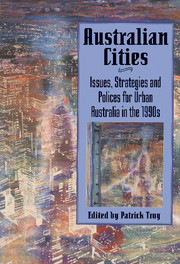Book contents
- Frontmatter
- Contents
- List of Figures
- List of Tables
- Preface
- Acknowledgements
- Note on Contributors
- Abbreviations
- Introduction
- Part I The Development and State of Australian Cities
- Part II Current Policies and Options
- 5 The Battle for Balmain
- 6 State Planning Operation
- 7 Planning in a Multicultural Environment: A Challenge for the Nineties
- 8 Local Government and the Urban Growth Debate
- 9 Towards More Equitable Cities: A Receding Prospect?
- Part III Avenues for Development
- References
- Index
8 - Local Government and the Urban Growth Debate
Published online by Cambridge University Press: 03 May 2011
- Frontmatter
- Contents
- List of Figures
- List of Tables
- Preface
- Acknowledgements
- Note on Contributors
- Abbreviations
- Introduction
- Part I The Development and State of Australian Cities
- Part II Current Policies and Options
- 5 The Battle for Balmain
- 6 State Planning Operation
- 7 Planning in a Multicultural Environment: A Challenge for the Nineties
- 8 Local Government and the Urban Growth Debate
- 9 Towards More Equitable Cities: A Receding Prospect?
- Part III Avenues for Development
- References
- Index
Summary
The perception of local government as the third and least relevant tier of government in urban planning is changing. The expansion of the role of local government in social and physical planning in the 1980s has led to a revolution in Australian town halls and the emergence of a more complex pattern of partnerships between governments, infrastructure authorities and the private sector. These changes are a response to the impact of global forces on Australian urban development which have resulted in dramatic population and economic changes in local areas. The relationship of global/local change is the essential framework for any meaningful analysis of local government and the urban debate.
Australia is not alone in experiencing change in inter-government relations as a result of world-wide trends in globalisation and internationalisation:
throughout the world, there are a series of changes taking place which impact on regional and local governments, forcing them to adapt their behaviour and to change their relationship with other levels of government vertically and horizontally … Some of these changes are political … some are social – greater migration, and social segregation of cities; but the major driving force has undoubtedly been that of economic change. (Goldsmith 1993:683)
World-wide trends in the trade of agricultural and mining products, the shift in the location of industrial/manufacturing activities, the growing importance of the financial and service sectors, the dominance of multinational interests and the communications revolution have especially impacted on Australian local communities.
- Type
- Chapter
- Information
- Australian CitiesIssues, Strategies and Policies for Urban Australia in the 1990s, pp. 179 - 195Publisher: Cambridge University PressPrint publication year: 1995
- 2
- Cited by



